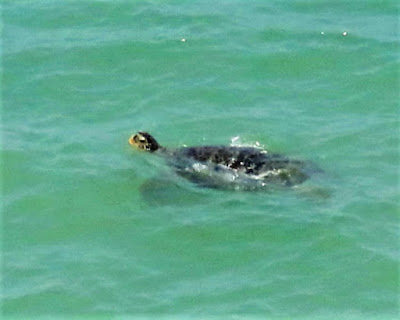You will probably realised by now that there are some things in this world which you can't really control - for example nature. Some even say it includes your mother-in law or perhaps your bosses too. But the most unpredictable of them all should be the weather. I decided to make a late trip on March 27 to this famous cape hoping to watch a bounty of migrant raptors flying across the Straits of Malacca. Unfortunately the wind was blowing towards the sea at that time. No birds would attempt to fly across the Straits in such conditions as it would be like driving against the traffic !
Nevertheless the resident birds did show up well and here are just some of them.
 |
| Purple-Throated Sunbird (Nectarinia sperata) |
Now you see it and now you don't !
From its scientific name you could probably guess that its main source of food are nectar.
Despite so many bees flying around, they did not stop this colorful sunbird taking nectar from the flowers.
Even its rump has some iridescent metallic blue color.
 |
| Purple-Throated Sunbird - female |
The color of its rump is basically olive green as compared to the male.
At about 10.30am, came this White-Bellied Sea Eagle (Haliaeetus leucogaster). It is one of the many huge raptors which you can find in Malaysia. You can also see its wedge shaped tail here. Apparently scientist are still debating whether the shape of a tail has any aerodynamic significance.
There were three (3) of them circling around the light house.
One of them decided to go after some squirrels at the tree tops.
 |
| Brahminy Kite (Haliastur indus) |
Germani Swiflet
There were quite a lot of them at that time.
This is a male Orange-Bellied Flowerpecker. Another stunning resident bird.
Didn't realise that this place has Olive-Winged Bulbul as well.
When things get a bit boring, nature has its own way of entertaining its guest.
So came this Green Turtle from the deep bluish emerald colored sea. I used to see three of them but only one appeared this time.
 |
| Painted Jezebel (Delias hyparete) |
 |
| Striped Albatross (Appias libythea) |
If you have been birding with some senior birders before, you will probably noticed that there are some birding etiquette which you would need to follow. If you are still not sure what they are, here are some of the dos and don'ts which you will need to observe when you go out with them.
Rule # 1: do not talk anything else to them except birds.
Rule # 2: do not say such things as "i ate two hornbills when i went camping last week". You will be a roasted swine in no time !
Rule # 3: do not ask silly questions such as "whether we can find California Condors in Fraser's Hill"? They are highly intelligent and successful people who spent half of their lives in the jungle and mudflats. Not forgetting paddy fields as well.
Rule # 4: Do not show them a photo of a caged bird even though the photo can launch a zillion ships.
Rule # 5: do shock them with some bombastic terminology such as "lore", "lateral crown stripe", "mantle", "primary fingers" etc although you may not necessarily know the real meaning of those words.
Rule # 6: do show and discuss with them the sketching you have made on the birds you have seen. Never mind if the sketches may look like a mongoose than a bird but i am sure the senior birders will be keen to listen to your explanations.
















No comments:
Post a Comment